|
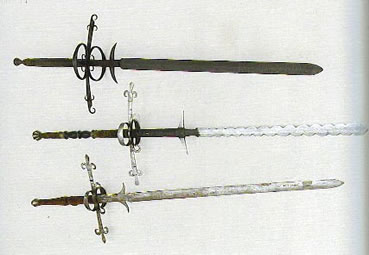 The
Weighty Issue of Two-Handed Greatswords The
Weighty Issue of Two-Handed Greatswords
By J. Clements
"never
overlay thy selfe with a heavy weapon, for nimblenesse of bodie,
and
nimblenesse of weapon are two chief helpes for thy advantage"
- Joseph Swetnam, 1617
The Schoole of the Noble and Worthy Science of Defence
Popular media, fantasy games, and uninformed historians frequently
give the impression that these immense weapons were awkward, unwieldy
and ponderously heavy. The facts confirm an entirely different
understanding.
Identification - Definition of the Two-Handed Great Sword
To understand what we are discussing it is important to first have
a working definition. The respected work, Swords and Hilt Weapons,
offers this description of the weapon:
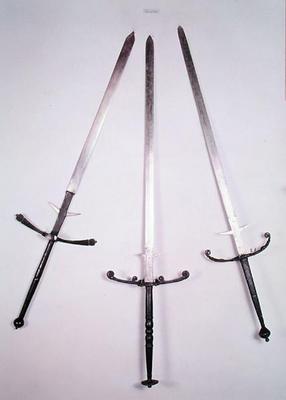 "The
two-handed sword was a specialized and effective infantry weapon,
and was recognized as such in the fifteenth and sixteenth centuries.
Although large, measuring 60-70 in/150-175 cm overall, it was not
as hefty as it looked, weighing something of the order of 5-8 lbs/2.3-3.6
kg. In the hands of the Swiss and German infantrymen it was lethal,
and its use was considered as special skill, often meriting extra
pay. Fifteenth-century examples usually have an expanded cruciform
hilt, sometimes with side rings on one or both sides of the quillon
block. This was the form which remained dominant in Italy during the
sixteenth century, but in Germany a more flamboyant form developed.
Two-handed swords typically have a generous ricasso to allow the blade
to be safely gripped below the quillons and thus wielded more effectively
at close quarters. Triangular or pointed projections, known as flukes,
were added at the base of the ricasso to defend the hand." (Coe et
al, p. 48) "The
two-handed sword was a specialized and effective infantry weapon,
and was recognized as such in the fifteenth and sixteenth centuries.
Although large, measuring 60-70 in/150-175 cm overall, it was not
as hefty as it looked, weighing something of the order of 5-8 lbs/2.3-3.6
kg. In the hands of the Swiss and German infantrymen it was lethal,
and its use was considered as special skill, often meriting extra
pay. Fifteenth-century examples usually have an expanded cruciform
hilt, sometimes with side rings on one or both sides of the quillon
block. This was the form which remained dominant in Italy during the
sixteenth century, but in Germany a more flamboyant form developed.
Two-handed swords typically have a generous ricasso to allow the blade
to be safely gripped below the quillons and thus wielded more effectively
at close quarters. Triangular or pointed projections, known as flukes,
were added at the base of the ricasso to defend the hand." (Coe et
al, p. 48)
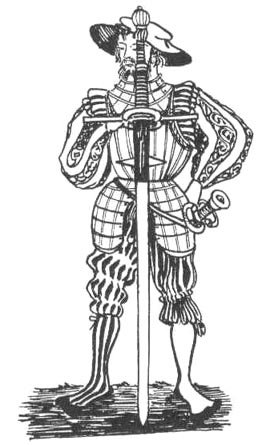 In
contrast to longswords, technically, true two-handed swords (epee's
a deux main) or "two-handers" were actually Renaissance, not
Medieval weapons. They are really those specialized forms of the later
1500-1600s, such as the Swiss/German Dopplehänder ("double-hander")
or Bidenhänder ("both-hander"). The popular names Zweihander
/ Zweyhander are actually relatively modern not historical
terms. English ones were sometimes referred to as "slaughter-swords"
after the German, Schlachterschwerter ("battle swords").
While used similarly to longswords, and even employed in some duels,
they were not identical in handling or performance. No major historical
teachings detailing fencing with these specific weapons are known.
These weapons were used primarily for fighting among pike-squares
where they would hack paths through knocking aside poles, possibly
even lobbing the ends off opposing halberds and pikes then slashing
and stabbing among the ranks. Wielded by the largest and most impressive
soldiers (Doppelsoldners, who received double pay), they
were also used to guard banners and castle walls. The Italian humanist
historian Paulus Jovius writing in the early 1500s also described
the two-hand great sword as being used by Swiss soldiers to chop the
shafts of pikes at the battle of Fornovo in 1495. In
contrast to longswords, technically, true two-handed swords (epee's
a deux main) or "two-handers" were actually Renaissance, not
Medieval weapons. They are really those specialized forms of the later
1500-1600s, such as the Swiss/German Dopplehänder ("double-hander")
or Bidenhänder ("both-hander"). The popular names Zweihander
/ Zweyhander are actually relatively modern not historical
terms. English ones were sometimes referred to as "slaughter-swords"
after the German, Schlachterschwerter ("battle swords").
While used similarly to longswords, and even employed in some duels,
they were not identical in handling or performance. No major historical
teachings detailing fencing with these specific weapons are known.
These weapons were used primarily for fighting among pike-squares
where they would hack paths through knocking aside poles, possibly
even lobbing the ends off opposing halberds and pikes then slashing
and stabbing among the ranks. Wielded by the largest and most impressive
soldiers (Doppelsoldners, who received double pay), they
were also used to guard banners and castle walls. The Italian humanist
historian Paulus Jovius writing in the early 1500s also described
the two-hand great sword as being used by Swiss soldiers to chop the
shafts of pikes at the battle of Fornovo in 1495.
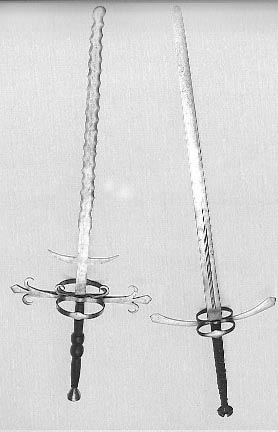 Many
of these weapons have compound-hilts with side-rings and enlarged
cross-guards of up to 12 inches. Most have small, pointed lugs or
flanges protruding from their blades 4-8 inches below their guard.
These parrierhaken or "parrying hooks" act almost as a secondary
guard for the ricasso to catch and bind other weapons or prevent them
from sliding down into the hands. They make up for the weapon's slowness
on the defence and can allow another blade to be momentarily trapped
or bound up. They can also be used to strike with. Certain wave or
flame-bladed two-handed swords have come to be known by collectors
as flamberges, although they are more appropriately known as flammards
or flambards (the German, Flammenschwert). The wave-blade
form is visually striking but really no more effective in its cutting
than a straight one. There were also huge two-handed blades known
as "bearing-swords" or "parade-swords" (Paratschwert), weighing
up to 10 or even 15 pounds and which were intended only for carrying
in ceremonial processions and parades. Many
of these weapons have compound-hilts with side-rings and enlarged
cross-guards of up to 12 inches. Most have small, pointed lugs or
flanges protruding from their blades 4-8 inches below their guard.
These parrierhaken or "parrying hooks" act almost as a secondary
guard for the ricasso to catch and bind other weapons or prevent them
from sliding down into the hands. They make up for the weapon's slowness
on the defence and can allow another blade to be momentarily trapped
or bound up. They can also be used to strike with. Certain wave or
flame-bladed two-handed swords have come to be known by collectors
as flamberges, although they are more appropriately known as flammards
or flambards (the German, Flammenschwert). The wave-blade
form is visually striking but really no more effective in its cutting
than a straight one. There were also huge two-handed blades known
as "bearing-swords" or "parade-swords" (Paratschwert), weighing
up to 10 or even 15 pounds and which were intended only for carrying
in ceremonial processions and parades.
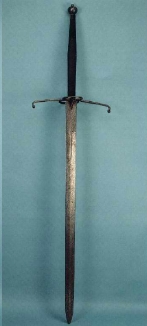 Dr.
Hans-Peter Hils in his 1985 dissertation on the work of the great
14th century master Johannes Liechtenauer noted that since the 19th
century many arms museum collections typically feature immense parade
or bearing greatswords as if they were actual combat weapons ignoring
the fact they are not only blunt edged, but of impractical size and
weight as well as poorly balanced for effective use. (Hils, p. 269-286).
Though never intended for actual fighting, examples of such ponderous
specimens are still occasionally cited incorrectly as having been
actual combat weapons. Dr.
Hans-Peter Hils in his 1985 dissertation on the work of the great
14th century master Johannes Liechtenauer noted that since the 19th
century many arms museum collections typically feature immense parade
or bearing greatswords as if they were actual combat weapons ignoring
the fact they are not only blunt edged, but of impractical size and
weight as well as poorly balanced for effective use. (Hils, p. 269-286).
Though never intended for actual fighting, examples of such ponderous
specimens are still occasionally cited incorrectly as having been
actual combat weapons.
One source tells us that among 16th century armies the adoption of
the two-handers was very limited and in comparison with the pike or
the halberd did not play a meaningful role. “In the infantry
unit, the German and Swiss Landsknechts positioned the Doppelsöldner
(Soldiers who received double pay for wielding the two-handers) in
the front ranks for a long time to strike down the opposing pikes
and to hack out breaches into which one's own soldiers could penetrate.
However it would become unusable, as soon as the opposing forces collided
with one another, and there would be increased pressure from the back
ranks onto the front ranks, which created a thick melee.”
Thus, “sometime around the middle of the 16th century it (the
two-hander) disappeared from war and mutated into a form of guard
and ceremonial weapon with a symbolic character.” (Kamniker
and Krenn, p. 130).
 As
one writer says of the weapon, "Among the smaller countries where
mercenary bands were likely to develop---the Low Countries, the Italian
city states, and the free cities and states of the German lands---the
Swiss became premier two-handed swordsmen for hire from the 14th century
until well into the 16th century. The two-handed sword and the multipurpose
polearm, called the halberd, were familiar Swiss trademarks. The Swiss
and Germans made their own two-handed swords. The Italians made a
basic two-hander that they exported throughout Europe. Two-handed
swordsmen were perimeter shock troops, trained to lay into approaching
knights or infantry and break their stride. By the end of the 15th
century, however, the Swiss had turned almost exclusively to the 17-
to 18-foot pike as their weapon of choice, becoming the premier pikemen
of Europe. The two-handed sword was considered incompatible with the
pike and was actually outlawed as a frontline weapon by many confederation
members--though the Swiss kept making them. The two-hander remained
a popular weapon among many other European mercenaries, in Italy and
particularly in Germany." (William J. McPeak. "For a Swordsmen with
Muscle as Well as Skill, Two Hands Could be Better Than One."
Military History, Oct 2001, Vol. 18. Issue 4, p 24). As
one writer says of the weapon, "Among the smaller countries where
mercenary bands were likely to develop---the Low Countries, the Italian
city states, and the free cities and states of the German lands---the
Swiss became premier two-handed swordsmen for hire from the 14th century
until well into the 16th century. The two-handed sword and the multipurpose
polearm, called the halberd, were familiar Swiss trademarks. The Swiss
and Germans made their own two-handed swords. The Italians made a
basic two-hander that they exported throughout Europe. Two-handed
swordsmen were perimeter shock troops, trained to lay into approaching
knights or infantry and break their stride. By the end of the 15th
century, however, the Swiss had turned almost exclusively to the 17-
to 18-foot pike as their weapon of choice, becoming the premier pikemen
of Europe. The two-handed sword was considered incompatible with the
pike and was actually outlawed as a frontline weapon by many confederation
members--though the Swiss kept making them. The two-hander remained
a popular weapon among many other European mercenaries, in Italy and
particularly in Germany." (William J. McPeak. "For a Swordsmen with
Muscle as Well as Skill, Two Hands Could be Better Than One."
Military History, Oct 2001, Vol. 18. Issue 4, p 24).
|
|
Answering the Weight Question - how much did the actual historic
weapons really weigh?
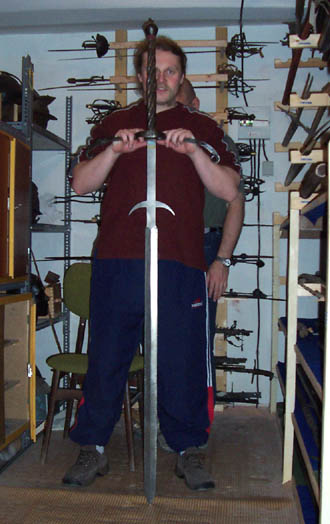 Nothing
answers the question of genuine weight better than sample evidence
of actual historical specimens. Sword collector and author Dr. Lee
Jones possesses a very fine specimen of a 16th century German two-handed
great sword, that this author had the privilege of exercising outdoors
with, had length in excess of five feet and a weight of 7.9 pounds
(3490g), but handled easily with superb balance. Curator of arms for
the Hungarian Military History Museum in Budapest, László Töl, describes
a very fine specimen of another 16th century German two-handed great
sword of 53.4 inches length, which this author also had the privilege
of examining, as weighing only a little over 8 pounds. Again,
the piece's size and weight betrayed a functional and well-balanced
weapon. László Töl adds: "The full length of the sword is 1808 mm,
the full length of the blade is 1355 mm, the edge of the blade is
936 mm long, the length of the hilt is 306 mm, and the diameter of
the cross-guard is 502 mm. The width of the blade is 46 mm, and its
thickness is 7.5 mm. The 'neck' of the blade is 8.6 mm thick and 32
mm wide. The centre of gravity is 616 mm from the pommel. The sword
weighs 3650g. The blade's cross-section is rhomboid in shape." Nothing
answers the question of genuine weight better than sample evidence
of actual historical specimens. Sword collector and author Dr. Lee
Jones possesses a very fine specimen of a 16th century German two-handed
great sword, that this author had the privilege of exercising outdoors
with, had length in excess of five feet and a weight of 7.9 pounds
(3490g), but handled easily with superb balance. Curator of arms for
the Hungarian Military History Museum in Budapest, László Töl, describes
a very fine specimen of another 16th century German two-handed great
sword of 53.4 inches length, which this author also had the privilege
of examining, as weighing only a little over 8 pounds. Again,
the piece's size and weight betrayed a functional and well-balanced
weapon. László Töl adds: "The full length of the sword is 1808 mm,
the full length of the blade is 1355 mm, the edge of the blade is
936 mm long, the length of the hilt is 306 mm, and the diameter of
the cross-guard is 502 mm. The width of the blade is 46 mm, and its
thickness is 7.5 mm. The 'neck' of the blade is 8.6 mm thick and 32
mm wide. The centre of gravity is 616 mm from the pommel. The sword
weighs 3650g. The blade's cross-section is rhomboid in shape."
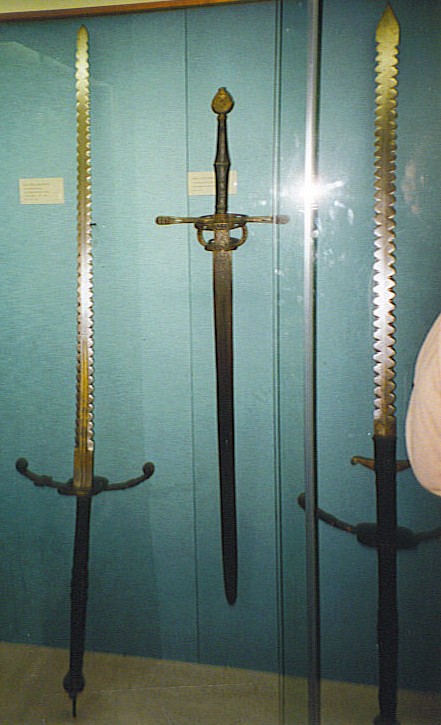 A
15th century two-handed Federschwert (practice sword) of
51.5 inches in length now at the Swiss National Landesmuseum weighs
in at only 3.12lbs (1.415kg). Another warsword there of 48 inches
in length weighs 4.63lbs (2.10kg), and an acutely tapered one of a
length of 46.7 inches weighs in at only 3.018lbs (1.369kg). By comparison,
a single-hand sword of 38-inches in the same collection weighed 3.28lbs
(1.495kg). A
15th century two-handed Federschwert (practice sword) of
51.5 inches in length now at the Swiss National Landesmuseum weighs
in at only 3.12lbs (1.415kg). Another warsword there of 48 inches
in length weighs 4.63lbs (2.10kg), and an acutely tapered one of a
length of 46.7 inches weighs in at only 3.018lbs (1.369kg). By comparison,
a single-hand sword of 38-inches in the same collection weighed 3.28lbs
(1.495kg).
The author has handled two-handed greatswords at the British Royal
Armouries in Leeds that were distinctly identifiable as fighting weapons.
The current curator of European edged weapons, Robert C. Woosnam-Savage,
at the Royal Armouries writes:
"The fighting two-handed sword, weighed (on average)
between 5-7 lbs. I give the following three examples, randomly chosen
from our own collections, which I hope are adequate to make the
point:
Two-handed sword, German, c.1550 (IX.926). Weight:
7 lb 6oz.
Two-handed sword, German, dated 1529 (IX.991). Weight:
5 lb 1oz.
Two-handed sword, Scottish, mid 16th century, (IX.926).
Weight: 5 lb 10oz.
|
A
40-Pound Sword?
By
C. Jarko
One
of the most outrageous (and wildly incorrect) statements made
about Medieval swords is that they were heavy and weighed
as much as 40 pounds. While the fact that this statement
even came once from a respected scholar and expert on Medieval
warfare is surprising, it's not at all an uncommon claim.
Let's take a look at just how large a sword would have to
be to weigh that much or anywhere close to it.
Simple
Science (with a little algebra thrown in): How do
we know Medieval swords weren't 40 pounds (or for that matter,
even 15 or 20 pounds)? The answer is density.
Density is a way of expressing how much an object (of
a certain size and of a given material) weighs.
The size of the object is expressed in terms of its volume.
Volume is the size of an object as measured by its length,
width and thickness (or height) and is expressed in cubic
inches. Written as a mathematical equation,
it looks like this:
V
= L x W x H.
One
cubic inch is one inch long by one inch wide by one inch thick.
For
the purpose of this discussion, we can use a simple three-dimensional
rectangle to represent our sword. Let's pick a typical
longsword with an overall length of 48 inches and a general
width of 2 inches (the widest part of the blade). We'll
get to the height later.
Swords
were made of carbon steel, which has a known density of roughly
0.284 pounds per cubic inch (lbs/per cubic inch). If
we know how much weight we have (in this case "40" pounds),
we can figure out how many cubic inches the object would have:
40
pounds divided by 0.284 (the density of steel) = 140.85 cubic
inches (the volume or "V" of a 40 pound sword).
Our
sword is 48 inches long, 2 inches wide and "H" inches thick,
thus: V = 48 x 2 x H. Using our volume of 140.85, we
can solve for H for which we get:
140.85
= 48 x 2 x H
140.85
= 96 x H
H=
1.47 inches (140.85 divided by 96)
This
means our steel sword is 48 inches long, 2 inches wide and
1.47 inches thick along its entire length.
This would definitely be a blunt object and not a sharp cutting
instrument like a sword.
Just
for fun, let's see what we get when we say a sword (again
48 inches long and 2 inches wide) weighs 15 pounds or 10 pounds:
15
pounds divided by 0.284 (the density of steel) = 52.82 cubic
inches (the volume "V" of a 15 pound sword).
Using
our volume of 52.82, we can solve for H:
52.82
= 48 x 2 x H
52.82
= 96 x H
H
= 0.55 inches (52.82 divided by 96)
That's
over half an inch thick, still a blunt object. Let's
try one more time for 10 pounds.
10
pounds divided by 0.284 (the density of steel) = 35.21 cubic
inches (the volume "V" of a 15 pound sword).
Again,
we can solve for H:
35.21
= 48 x 2 x H
35.21
= 96 x H
H
= 0.37 inches
That's
almost three eighths of an inch thick. If you look at
three eighths of an inch on a ruler, you'll see we are now
starting to get "sword-like" but we're still not there.
If
we do the math using the thickness of a real sword (say
an average 1/8th inch thick across a roughly 48" by 2" rectangle)
it turns out such it weighs a reasonable 3.408 pounds. Which,
when you take into account things like differential cross-section,
distal taper, edge bevel and overall taper of the blade geometry,
as well as the weight of the pommel and cross, then an average
weight of 2.5 - 3.5 pounds works out just about right. So,
the next time
When
someone says "a longsword weighs 15 pounds", you can reply,
"Oh, like this?" as you hand them 15 pounds of a half-inch
thick steel slab four feet long and two inches wide. There's
nothing like holding the truth in your hands. If there were
really battle swords that actually weighed 40 pounds, or even
just 15 or 20 pounds, then where are they? Why don't
we have a single historical example as proof? It would
be such an easy thing to prove. So, if you have a modern
made sword which you bought and it weighs far more than the
real life working versions of history, no matter what the
manufacture claims, that sword is just not made correctly.
When
we use the mathematical proof, we need to understand that
there are variables which we aren't taking into account here,
but this line of argument works well enough to debunk the
more outrageous claims about sword weight. The next
time you're arguing with someone who refuses to budge off
their claim that swords were very heavy and unwieldy, you
can tell them: "Hey, you do the math!"
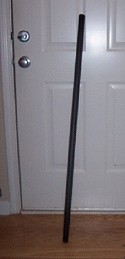
An
ordinary exercise bar (available at most large sporting goods
stores) is an excellent way to demonstrate how real swords
were not "heavy." These 50" poles come in 9, 12, and
14 pound versions and comparing the heft of such weight to
a sword blade makes it very clear how absurd a weapon of such
mass would be.
|
Arms authority, David Edge, former head curator and current conservator
of the famed Wallace Collection museum in London, similarly states
for us:
"I very recently had occasion to handle a couple of similar-sized
hand-and-a-half 16th-century 'heading' swords in the [Wallace] Collection…one
undoubtedly genuine (#A721) and one now thought to be a Victorian
fake (A723), albeit not described as such in the 1962 [Wallace Collection]
catalogue. The two swords handled completely and
dramatically differently…on checking their weights the genuine
one weighed 3 lbs. 12 oz., and felt like it could take a head off
with ease, while the fake weighed in at an unwieldy 5lbs 3 oz. and
to wield felt more like an iron bar intended to bludgeon the unfortunate
prisoner to death! Clearly making replica swords too heavy
is not the sole prerogative of modern manufacturers…Victorian
copyists appear sometimes to have fallen into the same trap!
It is interesting to compare these weights with that of a double-handed
fighting sword of similar date…for example, our Landsknecht
double-hander #A470, the one with a wavy blade. This (a much
larger sword all round) still only weighs a mere 7 lbs. 4 oz."
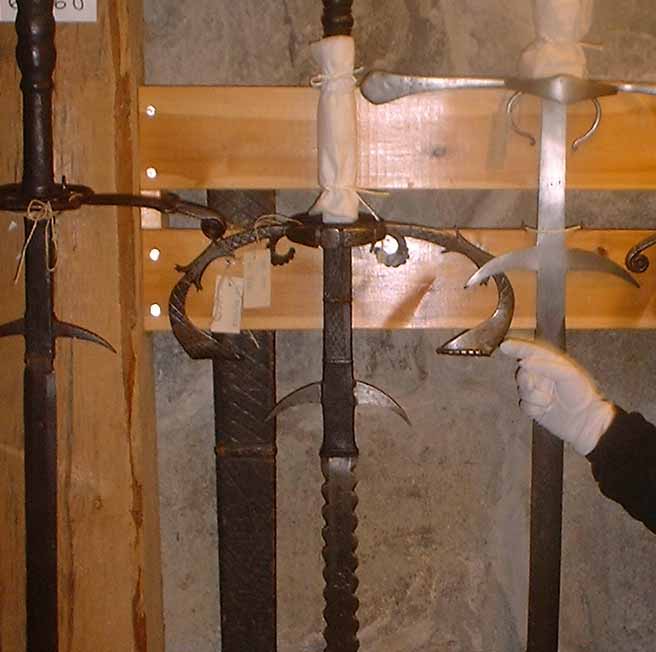 "Original
weapons are indeed far lighter than most people realize …3
lbs for an 'average' late-medieval cross-hilt sword, say, and 7-8
lbs for a Landsknecht two-handed sword, to give just a couple of
examples from weapons in this collection. Processional two-handed
swords are usually heavier, true, but rarely more than 10 lbs.
The heaviest and most enormous sword in our entire Armoury only
weighs 14 lbs and was probably ceremonial." "Original
weapons are indeed far lighter than most people realize …3
lbs for an 'average' late-medieval cross-hilt sword, say, and 7-8
lbs for a Landsknecht two-handed sword, to give just a couple of
examples from weapons in this collection. Processional two-handed
swords are usually heavier, true, but rarely more than 10 lbs.
The heaviest and most enormous sword in our entire Armoury only
weighs 14 lbs and was probably ceremonial."
ARMA consultant Henrik Andersson of the Livrustkammaren,
Swedish Royal Armoury of Stockholm, provides a table with the following
measurements on two-handed and greatswords in the collection there.
The author and his colleagues have handled several of these pieces:
Two-handed sword. No: LRK 13639.
Swedish, c1658
Length: 1010 mm (39.7 inches)
Blade: 862 mm (33.9 inches)
Weight: 1735 g (3.47 pounds) |
Ceremonial Two-handed sword.
No: LRK 5666.
Swedish, c1658.
Length: 1025 mm (40.3 inches)
Blade: 933 mm (36.7 inches)
Weight: 1590 g (3.18 pounds) |
Two-handed sword. No: LRK 12959.
Solingen, Early 17th century.
Length: 1350 mm (56.2 inches)
Blade: 961 mm (37.8 inches)
Weight: 3010 g (6.2 pounds) |
Two-handed sword. No: LRK 16660.
German, 17th century.
Length: 1428 mm ( inches)
Blade: 1048 mm ( inches)
Weight: 2730 g (5.46 pounds) |
Two-handed sword. No: LRK 16662.
German, Late 16th century.
Length: 1790 mm (70.4 inches)
Blade: 1250 mm (49.2 inches)
Weight: 4630 g (9.26 pounds) |
One-and -a-half-handed sword.
No: LRK 10972.
Southern German, c1550.
Length: 1252 mm ( inches)
Blade: 1019 mm ( inches)
Weight: 1500 g (3 pounds) |
Two-handed sword. No: LRK 12947.
German, 16th century.
Length: 1185 mm (46.6 inches)
Blade: 954 mm (37.5 inches)
Weight: 1240 g (2.48 pounds) |
Two-handed sword. No: LRK 12667.
German, 16th century.
Length: 1225 mm (48.2 inches)
Blade: 904 mm (35.5 inches)
Weight: 1310 g (2.62 pounds) |
One-and -a-half-handed sword.
No: LRK 12913.
Probably German, c. 1350
Length: 1170 mm (46 inches)
Blade: 829 mm (32.6 inches)
Weight: 1280 g (2.56 pounds) |
Two-handed sword. No: LRK 12716.
German, c1500.
Length: 1340 mm (52.7 inches)
Blade: 955 mm (37.6 inches)
Weight: 1390 gr\ (3 lbs) |
One-and -a-half-handed sword.
No: LRK 12711.
German, c1475-1525.
Length: 1153 mm (45.3 inches)
Blade: 932 mm (36.6 inches)
Weight: 1320 g (2.9 lbs) |
Ceremonial Two-handed sword.
No: LRK 6362.
German (probably Passau) c1600.
Length: 1275 mm (50.1 inches)
Blade: 1000 mm (39.37inches)
Weight: 2330 g (5.1 lbs) |
Ceremonial Two-handed sword.
No: LRK 16370.
German. Late 16th century.
Length: 1422 mm (55.9 inches)
Blade 1029 mm (40.5 inches)
Weight: 2700 g (5.9 lbs) |
Ceremonial Two-handed sword.
No: LRK 6956.
Brunswick type. German. Late 16th century.
Length: 1893 mm (74.5 inches)
Blade: 1313 mm (51.7 inches)
Weight: 4830 gr (10.6 lbs) |
Ceremonial Two-handed sword.
No: LRK 6941.
Brunswick type. German. Late 16th century.
Length: 1817 mm (71.5 inches)
Blade: 1240 mm (48.8 inches)
Weight: 3970 g (8.75 lbs) |
Ceremonial Two-handed sword.
No: LRK 16371.
Brunswick type. Munich, c1550-1575.
Length: 1643 mm (64.7 inches)
Blade: 964 mm (37.9 inches)
Weight: 3500 g (7.7 lbs) |
Two-handed sword. No: LRK 12706.
German. Late 15th century.
Length: 1473 mm (58 inches)
Blade: 1066 mm (41.9 inches)
Weight: 2720 g (5.9 lbs) |
Two-handed sword. No: LRK 12715.
German, c1475-1525.
Length: 1382 mm (54.4 inches)
Blade: 1055 mm (41.5 inches)
Weight: 1550 g (3.4 lbs) |
Two-handed sword. No: LRK 5480.
Germany, 15th century.
Length: 1375 mm (54.2 inches)
Blade: 920 mm (36.2 inches)
Weight: 1600 g (3.5 lbs) |
|
Note that unlike ceremonial specimens, none of the fighting weapons
exceeded 4 pounds and the heaviest ceremonial was less than 11. The
catlog of the famous arsenal in Graz, Austria, contains similar weights
for its two-handed great sword specimens.
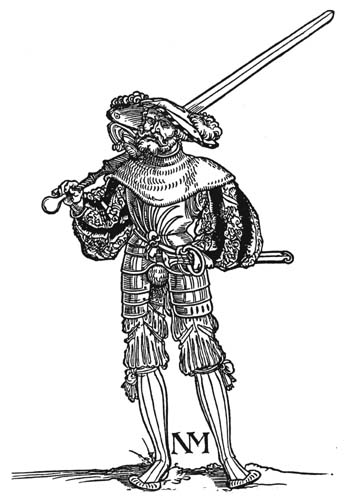 Historical
fencing researcher and author, Grzegorz Zabinski, observes, "It can
be assumed that the two-handed infantry swords were a culminating
point of one of the directions of the evolution of swords, that aimed
to increase their efficiency against plate by means of increasing
their dimensions and weight, and, quite naturally, their impact."
Zabinski offers sample data for a range of two-handed infantry swords
from the end of the 15th and the beginning of the 16th centuries at
the excellent collection of such weapons housed in the State Art Collection
at the Royal Castle of Wawel, Krakow, Poland: Historical
fencing researcher and author, Grzegorz Zabinski, observes, "It can
be assumed that the two-handed infantry swords were a culminating
point of one of the directions of the evolution of swords, that aimed
to increase their efficiency against plate by means of increasing
their dimensions and weight, and, quite naturally, their impact."
Zabinski offers sample data for a range of two-handed infantry swords
from the end of the 15th and the beginning of the 16th centuries at
the excellent collection of such weapons housed in the State Art Collection
at the Royal Castle of Wawel, Krakow, Poland:
Two-Handed Infantry Sword with parrying-hooks. No.
4434. Late 15th - early 16th century. Total length 167 cm (65.7
inches), total weight 3 kg (6 pounds), blade length 117 cm, hilt
length 50 cm, crosspiece length 34 cm. Blade's width at the shoulder
43 mm, at the parrying-hooks 36 mm, behind the parrying-hooks 50
mm, at the point 33 mm. Blade's thickness at the shoulder 11 mm.
Two-Handed Infantry Sword with parrying-hooks. No.
4435. Early 16th century. Total length 158 cm (62 inches), total
weight 3.10 kg (6.2 pounds), blade length 114.5 cm, hilt length
44 cm, crosspiece length 41.5 cm. Blade's width at the shoulder
33 mm, width at the point 58 mm. Blade's thickness at the shoulder
9 mm.
Two-Handed Infantry Sword with side-rings. No. 4437.Early
16th century. Total length 163 cm (64 inches), total weight 3.25
kg (6.5 pounds), blade length 125 cm, hilt length 38 cm, crosspiece
length 38 cm. Blade's width at the shoulder 53mm, at the point 30
mm. Blade's thickness at the shoulder 8 mm, at the point 2 mm.
Two-Handed Infantry Swordwith parrying-hooks. No.
4440. Late 15th - early 16th century. Total length 167 cm (65.7
inches), total weight 3 kg(6 pounds), blade length 122.2 cm (48
inches), hilt length 44.5 cm, crosspiece length 39 cm. Blade's width
at the shoulder 47 mm, at the point 26 mm. Blade's thickness at
the shoulder 7 mm, at the point 2 mm. The parrying-hooks: total
length 13.7 cm, pointed, width at the shoulder 1.5 cm.
Two-Handed Infantry Sword.National Museum Wroclaw.
No. IX-780. Late 15th - early 16th century. Total length 148 cm
(58 inches), total weight 2 kg (4 pounds), blade length 107.5 cm,
hilt length 39.8 cm, crosspiece length 31.3 cm. Blade's width at
the shoulder 38 mm, at the point 33 mm. Blade's thickness at the
shoulder 10 mm, at the point 4 mm.
Two-Handed Infantry Sword with parrying-hooks. National
Museum Wroclaw, No. IX-784. Early 16th century. Total length 164
cm (64 inches), total weight 2 kg (4 pounds), blade length 146.8
cm, hilt length 45.8 cm, crosspiece length 39.4 cm. Blade's width
at the shoulder 35 mm. Blade's thickness 10 mm at the shoulder,
2.5 mm at the point. The pommel's height (base included) 5.4 cm,
base's height 5 mm, pommel's diameter 5.4 cm.
Note
that of the samples here the heaviest is less than 7 and a half
pounds and one particularly large weapon of 58 inches weighs no
more than 4 pounds.
A practical explanation for the futility of especially
heavy weapons is that they are slow. In physics terms, doubling the
mass of a weapon can provide twice the strike energy, but doubling
the velocity of a strike provides four times the energy.
Below is a table of measurements from 69 two-handed great swords
from the 16th century in the famed Austrian arsenal of Graz (K. Kamniker
and P. Krenn, p. 139-152). Note that the average weight is less than
8 pounds at an average length of 67 inches. The weapons in the collection
range up to 5 pounds difference in their weight. The lightest weapon,
a slender blade, is just over than 3.3 pounds (at roughly 57 inches
long) while the heaviest, a large and elaborately hilted piece, is
no more than 13 pounds (at about 78 inches a long):
| Sword
Number |
Length
in cm |
Weight
in kg |
Length
in inches |
Weight
in pounds |
| 1 |
169 |
3.76 |
66.5 |
8.2 |
| 2 |
168 |
3.44 |
66.1 |
7.5 |
| 3 |
156 |
3.08 |
61.4 |
6.7 |
| 4 |
169 |
3.13 |
66.5 |
6.9 |
| 5 |
172 |
3.5 |
67.7 |
7.7 |
| 6 |
180.5 |
4.35 |
71.0 |
9.5 |
| 7 |
184 |
3.66 |
72.4 |
8.0 |
| 8 |
170.5 |
3.6 |
67.1 |
7.9 |
| 9 |
195.5 |
5.92 |
76.9 |
13.0 |
| 10 |
197 |
5.4 |
77.5 |
11.9 |
| 11 |
186.5 |
4.33 |
73.4 |
9.5 |
| 12 |
180.5 |
4.28 |
71.0 |
9.4 |
| 13 |
178 |
3.51 |
70.0 |
7.7 |
| 14 |
182 |
3.75 |
71.6 |
8.2 |
| 15 |
186 |
3.93 |
73.2 |
8.6 |
| 16 |
199 |
5.42 |
78.3 |
11.9 |
| 17 |
187.5 |
4.7 |
73.8 |
10.3 |
| 18 |
175.5 |
3.64 |
69.0 |
8.0 |
| 19 |
162 |
3.28 |
63.7 |
7.2 |
| 20 |
168.5 |
2.45 |
66.3 |
5.4 |
| 21 |
170.5 |
3.37 |
67.1 |
7.4 |
| 22 |
158.5 |
2.88 |
62.4 |
6.3 |
| 23 |
170.5 |
3.67 |
67.1 |
8.0 |
| 24 |
164.5 |
3.8 |
64.7 |
8.3 |
| 25 |
158 |
3.11 |
62.2 |
6.8 |
| 26 |
168.5 |
3.39 |
66.3 |
7.41 |
| 27 |
173.5 |
3.73 |
68.3 |
8.2 |
| 28 |
170.5 |
3.51 |
67.1 |
7.7 |
| 29 |
176.5 |
3.63 |
69.4 |
8.0 |
| 30 |
176 |
3.77 |
69.2 |
8.3 |
| 31 |
174.5 |
3.78 |
68.7 |
8.3 |
| 32 |
170 |
3.17 |
66.9 |
6.9 |
| 33 |
176 |
4.3 |
69.2 |
9.4 |
| 34 |
169 |
4.2 |
66.5 |
9.2 |
| 35 |
169 |
2.95 |
66.5 |
6.5 |
| 36 |
190 |
5.04 |
74.8 |
11.1 |
| 37 |
183 |
4.73 |
72.0 |
10.4 |
| 38 |
173 |
3.46 |
68.1 |
7.6 |
| 39 |
167 |
3.83 |
65.7 |
8.4 |
| 40 |
187 |
4.73 |
73.6 |
10.4 |
| 41 |
180.5 |
3.79 |
71.0 |
8.3 |
| 42 |
180.5 |
4.64 |
71.0 |
10.2 |
| 43 |
150 |
2.93 |
59.0 |
6.4 |
| 44 |
164.5 |
3.67 |
64.7 |
8.0 |
| 45 |
171 |
3.39 |
67.3 |
7.4 |
| 46 |
171.5 |
3.55 |
67.5 |
7.8 |
| 47 |
167.5 |
3.45 |
65.9 |
7.6 |
| 48 |
175.5 |
3.85 |
69.0 |
8.4 |
| 49 |
171 |
3.51 |
67.3 |
7.7 |
| 50 |
175.5 |
3.57 |
69.0 |
7.8 |
| 51 |
160 |
2.96 |
62.9 |
6.5 |
| 52 |
168.5 |
3.2 |
66.3 |
7.0 |
| 53 |
168.5 |
3.52 |
66.3 |
7.7 |
| 54 |
159.5 |
3.32 |
62.7 |
7.3 |
| 55 |
151 |
2.96 |
59.4 |
6.5 |
| 56 |
149 |
2.89 |
58.6 |
6.3 |
| 57 |
150.5 |
3.1 |
59.2 |
6.8 |
| 58 |
174.5 |
3.55 |
68.7 |
7.8 |
| 59 |
155.5 |
3.06 |
61.2 |
6.7 |
| 60 |
155.5 |
3.21 |
61.2 |
7.0 |
| 61 |
161 |
3.07 |
63.3 |
6.7 |
| 62 |
157 |
3.18 |
61.8 |
7.0 |
| 63 |
144.5 |
3.18 |
56.8 |
7.0 |
| 64 |
159.5 |
3.14 |
62.7 |
6.9 |
| 65 |
177 |
2.7 |
69.6 |
5.9 |
| 66 |
185 |
1.72 |
72.8 |
3.8 |
| 67 |
160 |
1.71 |
62.9 |
3.7 |
| 68 |
159 |
1.52 |
62.5 |
3.3 |
| 69 |
158.5 |
1.56 |
62.4 |
3.4 |
| |
|
|
|
|
| |
|
|
|
|
| Stats |
Length
in cm |
Weight
in kg |
Length
in inches |
Weight
in pounds |
| Min. |
144.5 |
1.52 |
56.9 |
3.3 |
| Max. |
199 |
5.92 |
78.3 |
13.0 |
| Average |
170.6 |
3.5 |
67.1 |
7.8 |
| Mode |
169 |
3.51 |
66.5 |
7.7 |
|



|
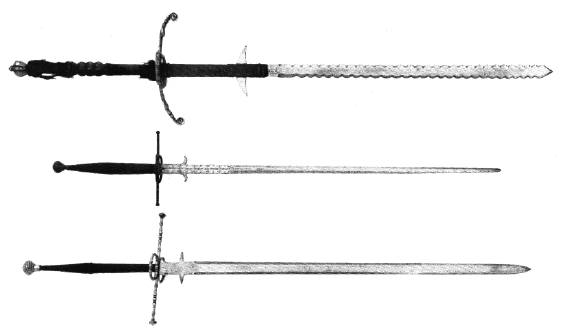
Conclusion
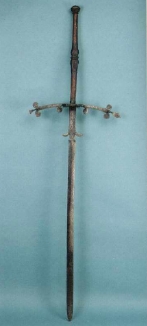 A
sword's weight cannot be judged just from its size or blade width.
Hilt style and blade cross-section are determining factors in a weapon's
mass. Just because a blade is thinner does not mean it is necessarily
lighter. For example, an Italian side-sword from circa 1550-1560 of
43.5 inches length weighs in at only 2 pounds 6 ounces, while a typical
rapier that is much more slender bladed from the same era but just
a few inches longer, weighs 2 pounds 9 ounces and still another only
5 inches longer at 3 pounds 3 ounces.From the late 1400s, a large
double-handed Kriegsmesser (or "war knife") of 49.5 inches
length is listed as weighing only 3.8 pounds (see the Metropolitan's
1982, Art of Chivalry, p. 90 & 93-94 for samples). A
sword's weight cannot be judged just from its size or blade width.
Hilt style and blade cross-section are determining factors in a weapon's
mass. Just because a blade is thinner does not mean it is necessarily
lighter. For example, an Italian side-sword from circa 1550-1560 of
43.5 inches length weighs in at only 2 pounds 6 ounces, while a typical
rapier that is much more slender bladed from the same era but just
a few inches longer, weighs 2 pounds 9 ounces and still another only
5 inches longer at 3 pounds 3 ounces.From the late 1400s, a large
double-handed Kriegsmesser (or "war knife") of 49.5 inches
length is listed as weighing only 3.8 pounds (see the Metropolitan's
1982, Art of Chivalry, p. 90 & 93-94 for samples).
One historian states, "The true two-handers really did require two
hands, though their overall weight averaged only about 8 to 10 pounds.
With blades of up to 45 inches or more, the hilts had to be at least
9 inches to counterbalance such a long blade. The crossguard's length
also helped in distributing weight." (William J. McPeak. "For a Swordsmen
with Muscle as Well as Skill, Two Hands Could be Better Than One".
Military History, Oct 2001, Vol. 18. Issue 4, p 24).
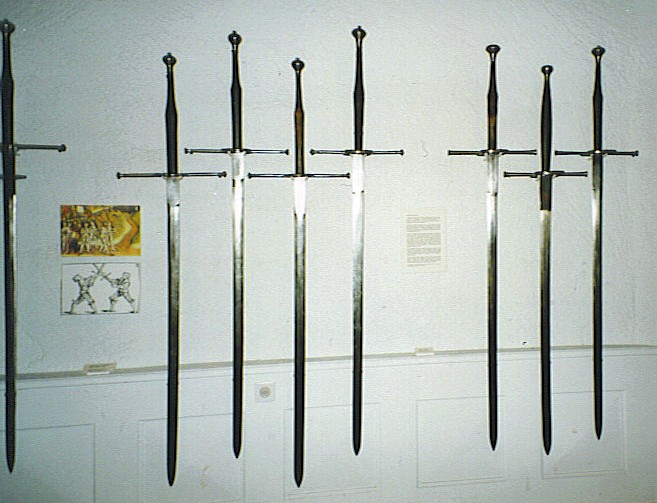
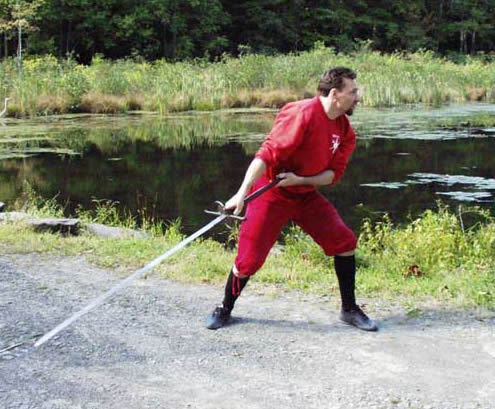 Despite
the facts above, many are convinced today that these large swords
simply are, or even have to be, exceptionally heavy. The view is not
one limited to modern times. For example, Thomas Page's otherwise
unremarkable 1746 military fencing booklet, The Use of the Broad
Sword, exclaimed nonsense about earlier swords that became largely
accepted as fact in the 19th (and 20th) century. Revealing something
of how much things in that period had changed from earlier skills
and knowledge of martial fencing, declared how their: "Form was rude,
and their use without Method. They were the Instruments of Strength,
not the Weapons of Art. The Sword was enormous length and breadth,
heavy and unwieldy, design'd only for right down chopping by the Force
of a strong Arm." (Page, p. A3). Page's views were not uncommon among
fencers then used to featherweight smallswords and the occasional
saber and short cutlass. Despite
the facts above, many are convinced today that these large swords
simply are, or even have to be, exceptionally heavy. The view is not
one limited to modern times. For example, Thomas Page's otherwise
unremarkable 1746 military fencing booklet, The Use of the Broad
Sword, exclaimed nonsense about earlier swords that became largely
accepted as fact in the 19th (and 20th) century. Revealing something
of how much things in that period had changed from earlier skills
and knowledge of martial fencing, declared how their: "Form was rude,
and their use without Method. They were the Instruments of Strength,
not the Weapons of Art. The Sword was enormous length and breadth,
heavy and unwieldy, design'd only for right down chopping by the Force
of a strong Arm." (Page, p. A3). Page's views were not uncommon among
fencers then used to featherweight smallswords and the occasional
saber and short cutlass.
 European
sword making technologies throughout the Middle Ages and Renaissance
were quite capable of producing high-quality, lightweight, and flexible
steel blades for cutting swords that could hold keen edges. These
weapons were not intended to defeat heavy plate armor with powerful
cuts but did evolve from those longswords that were developed for
use against armors by thrusting rather than cutting. Handling
real specimens of some of these enormous but beautiful weapons [such
as seen in the three images to the right] is enlightening, for their
size betrays their exceptional balance. It very quickly becomes clear
they were intended for large fighting men to deliver not only powerful
slashing blows but great stabbing attacks as well as pole-weapon-like
techniques. Large as they were, they were not ridiculously heavy. European
sword making technologies throughout the Middle Ages and Renaissance
were quite capable of producing high-quality, lightweight, and flexible
steel blades for cutting swords that could hold keen edges. These
weapons were not intended to defeat heavy plate armor with powerful
cuts but did evolve from those longswords that were developed for
use against armors by thrusting rather than cutting. Handling
real specimens of some of these enormous but beautiful weapons [such
as seen in the three images to the right] is enlightening, for their
size betrays their exceptional balance. It very quickly becomes clear
they were intended for large fighting men to deliver not only powerful
slashing blows but great stabbing attacks as well as pole-weapon-like
techniques. Large as they were, they were not ridiculously heavy.
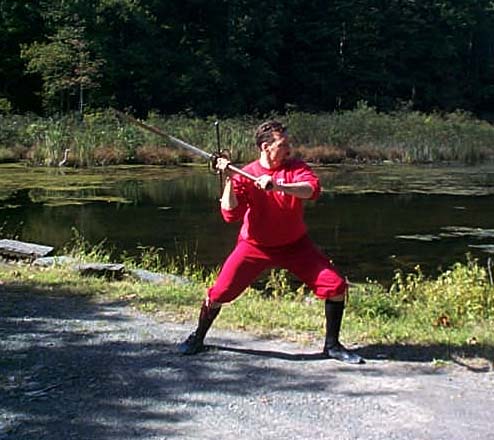 For
more than a century two-handed greatswords were used less for fighting
against armors and more for open battlefield where pike and halberd
formations were combined with firearms. Accordingly, just as with
its shorter single-hand cousins, the late 15th and early 16th century
two-handed greatsword was not a crude excessively heavy bludgeoning
weapon but a fairly agile and balanced weapon designed for close-combat
in war and occasional duel. For
more than a century two-handed greatswords were used less for fighting
against armors and more for open battlefield where pike and halberd
formations were combined with firearms. Accordingly, just as with
its shorter single-hand cousins, the late 15th and early 16th century
two-handed greatsword was not a crude excessively heavy bludgeoning
weapon but a fairly agile and balanced weapon designed for close-combat
in war and occasional duel.
Appreciation to Grzegorz Zabinski for sharing
additional data and Stewart Feil for editing assistance. All
quotes here are provided by permission of the sources.
See also: What
Did Medieval Swords Weigh?
October 2004
|


